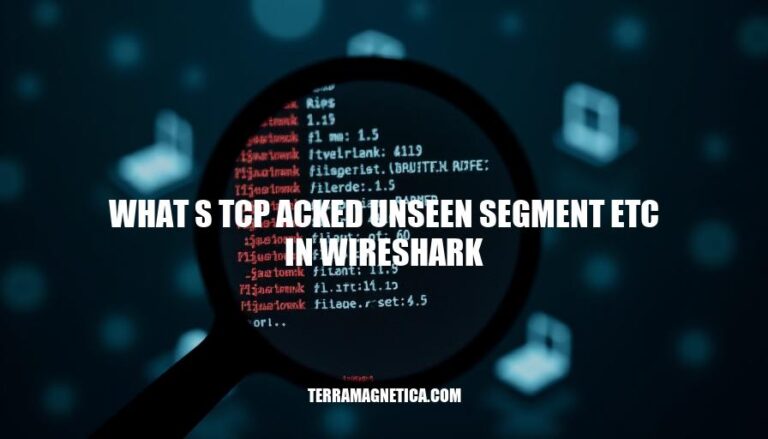In Wireshark, the term “TCP ACKed unseen segment” indicates that an acknowledgment (ACK) has been received for a data segment that wasn’t captured in the packet trace. This typically happens when the capture device misses some packets due to high traffic or limited capture performance.
Understanding this helps network analysts identify potential issues with packet loss or capture inefficiencies, ensuring more accurate network diagnostics and troubleshooting.
Definition of TCP ACKed Unseen Segment
In Wireshark, the term “TCP ACKed unseen segment” refers to a situation where an acknowledgment (ACK) packet is seen for data segments that were not captured in the network trace. This means that the data was successfully received and acknowledged by the receiver, but the actual data packets were not recorded in the capture. This often happens due to the capture device not being fast enough to record all packets.
Causes of TCP ACKed Unseen Segment
Here are some common causes of the ‘TCP ACKed unseen segment’ message in Wireshark:
- Packet Loss: When packets are lost in transit, the receiver may acknowledge packets that the capturing tool didn’t see.
- Network Congestion: High traffic can lead to packet drops, causing the capture tool to miss some packets.
- Insufficient Capture Capabilities: If the capture tool or network interface card (NIC) can’t keep up with the traffic, it may drop packets.
- Asymmetrical Routing: Packets and their acknowledgments might take different paths, leading to missing segments in the capture.
- Capture Start Mid-Connection: Starting the capture after a TCP connection has already been established can result in missing initial packets.
These issues can often be mitigated by improving capture hardware, using capture filters, or ensuring symmetrical routing paths.
Implications for Network Analysis
Encountering a “TCP acked unseen segment” during network analysis indicates that an acknowledgment (ACK) was received for a TCP segment that wasn’t captured or seen by the monitoring tool. This can have several implications:
-
Troubleshooting:
- Capture Issues: It often suggests packet loss during capture, possibly due to the capture tool not keeping up with traffic.
- Network Congestion: It can indicate network congestion, causing delays or dropped packets.
- Asymmetrical Routing: Data and ACKs might be traveling on different paths, leading to incomplete captures.
-
Data Integrity:
- Order Disruption: Applications relying on packet order may face issues, as unseen segments can disrupt the expected sequence.
- Retransmissions: The sender might retransmit segments, potentially leading to duplicate data and increased latency.
Addressing these issues involves improving capture methods, reducing network congestion, and ensuring symmetrical data paths.
Mitigation Strategies
To mitigate the occurrence of ‘TCP ACKed unseen segment’ in Wireshark, consider the following strategies:
-
Improve Capture Hardware:
- Use high-performance network interface cards (NICs) with better packet capture capabilities.
- Employ dedicated capture devices or network taps to ensure all traffic is captured without loss.
-
Use Capture Filters:
- Apply capture filters to reduce the volume of traffic being captured, focusing only on relevant packets.
- Example filter:
tcp port 80 to capture only HTTP traffic.
-
Optimize Network Configurations:
- Ensure symmetrical routing paths to avoid missing segments due to asymmetric routing.
- Reduce network congestion by managing bandwidth and prioritizing critical traffic.
- Increase the size of the receiver’s receive window to handle more data efficiently.
Implementing these strategies can help you achieve more accurate and reliable packet captures in Wireshark.
The ‘TCP ACKed unseen segment’ message in Wireshark
indicates that an acknowledgment (ACK) was received for a TCP segment that wasn’t captured or seen by the monitoring tool, often due to packet loss, network congestion, or capture inefficiencies. This can lead to troubleshooting issues, data integrity problems, and order disruption.
Solutions
To address this, consider the following strategies:
- Improve capture hardware: Ensure that your capture hardware is capable of handling high-speed networks and can capture packets efficiently.
- Use capture filters: Implement capture filters to reduce the amount of data being captured and only focus on relevant traffic.
- Optimize network configurations:
- Symmetrical routing paths: Ensure that your network has symmetrical routing paths to prevent packet loss and congestion.
- Reduce network congestion: Implement measures to reduce network congestion, such as Quality of Service (QoS) policies or traffic shaping.
- Increase receive window size: Increase the receive window size on your capture device to allow for more packets to be captured before they are dropped.
Conclusion
By implementing these strategies, you can achieve more accurate and reliable packet captures in Wireshark, which is essential for troubleshooting network issues and ensuring data integrity.


